From Gangwon 2024 to Paris 2024: Innovative broadcast and digital technologies in action

International Olympic Committee
25 January 2024 – In addition to the thrilling sporting action, the Youth Olympic Games (YOG) are a playground for innovation and experimentation in the broadcasting and digital domains. At the Winter Youth Olympic Games Gangwon 2024, innovative broadcast and digital technologies and concepts are helping to bring all the magic of the youth-led event to more people, in more places, in more ways, and are being tested for the Olympic Games Paris 2024.
More coverage of all the sporting action and athlete stories from Gangwon 2024
Some 170 hours of live coverage has been planned for Gangwon 2024 – an increase from Lausanne 2020 – as well as highlights of every event and sport. With 22 Media Rights-Holders (MRHs) covering 199 different territories, the expectation is to have 3,200 hours of the YOG on air.
This is complemented by extensive and varied coverage in 11 languages on Olympics.com, which has established itself as one of the strongest sports platforms globally, reaching 115 million people in 2023.
“Sixteen per cent of the medals won at Beijing 2022 were won by athletes who competed before at the Winter Youth Olympic Games. This is the making of future Olympians, so it is essential to us that we not only show the world the competition, but also tell the young athletes’ stories and give them a platform through wider content, such as interviews and behind the scenes on Olympics digital and social platforms.”
Yiannis Exarchos, Olympic Broadcasting Services CEO
The event is already benefitting from this extensive coverage and focus on storytelling, with an x1.6 increase in traffic to Olympics.com compared to Lausanne 2020; and social media engagement is expected to reach the 200 million target. Almost half of the traffic on Olympics.com related to Gangwon 2024 comes from the Korean market.
Engaging new audiences through innovative digital concepts and connecting to culture
For the first time, people can experience the Olympics in the metaverse. In a virtual world created with the Gangwon Organising Committee and the Gangwon Do Province, fans can look around the venues, compete in winter sports mini-games and interact with each other. People based in the Republic of Korea are also able to stream the sporting action.
Through a first-of-its-kind collaboration with Pinterest, people are invited to discover and explore the creativity and culture that surround winter sports. A host of Pinterest creators from across the world are making and sharing Winter YOG Gangwon 2024 content – from figure skating make-up, to Olympic themed nails and winter sports fashion.
Several digital creators and cultural collaborators have been invited to experience South Korean culture and the Olympics first-hand. They are creating and sharing content that offers a unique perspective.
Testing innovative broadcast and digital technology for Paris 2024
With less than 200 days to go to Paris 2024, the YOG present an important opportunity for testing technologies and concepts for the upcoming Olympic Games.
Artificial intelligence (AI) automation is being trialled in Gangwon 2024 – something that can be a transformative technology, creating efficiencies across production and editing workflows.
This includes Olympic Broadcasting Services (OBS) Automatic Highlights Generation, in collaboration with Intel, and OBS Generative Assisted Editing. AI live production technology is also being tested at the Gangwon ice hockey event. The technology is not yet fully mature, but has immense potential.
AI is also enhancing the Olympics.com experience, making it easier for fans to find the right content and tools to help editors. It is also informing social media content, testing cutting-edge artificial intelligence tools such as social listening to inspire content and distribution and AI-powered live clippings from Worldwide Olympic Partner Intel.
A virtual broadcast technology stack that mirrors the functions of a traditional production van is being tested out with Intel. Using software, servers and cloud technology instead of physical broadcast equipment enables remote production, which reduces the need for on-site personnel, and reduces broadcast footprint in terms of lower-power consumption and physical space.
Other figures that demonstrate the reduced broadcast footprint are:
- The space in the International Broadcasting Centre (IBC) has been reduced 13 per cent from Tokyo 2020 and 23 per cent compared to Rio 2016.
- The power provided by the Organising Committee for the IBC has been reduced by 44 per cent compared to Tokyo 2020 and 72 per cent compared to Rio 2016.
- The venue compound space has been reduced by 11 per cent from Tokyo 2020 and 20 per cent from Rio 2016.
- The venue broadcast power has been reduced by 29 per cent from Tokyo 2020 and 46 per cent from Rio 2016.
Listen to Yiannis Exarchos and Leandro Larrosa discuss Olympic broadcast and digital innovation from Gangwon 2024 here.
Find the full presentaition here





